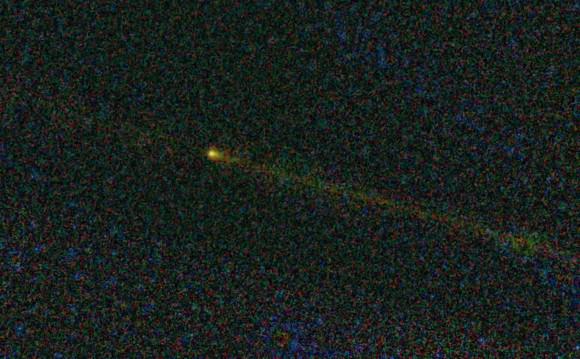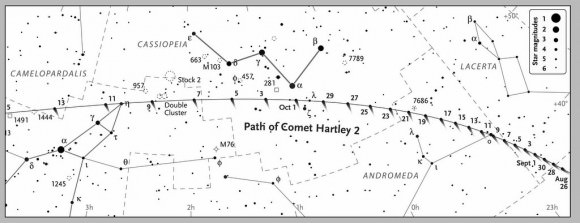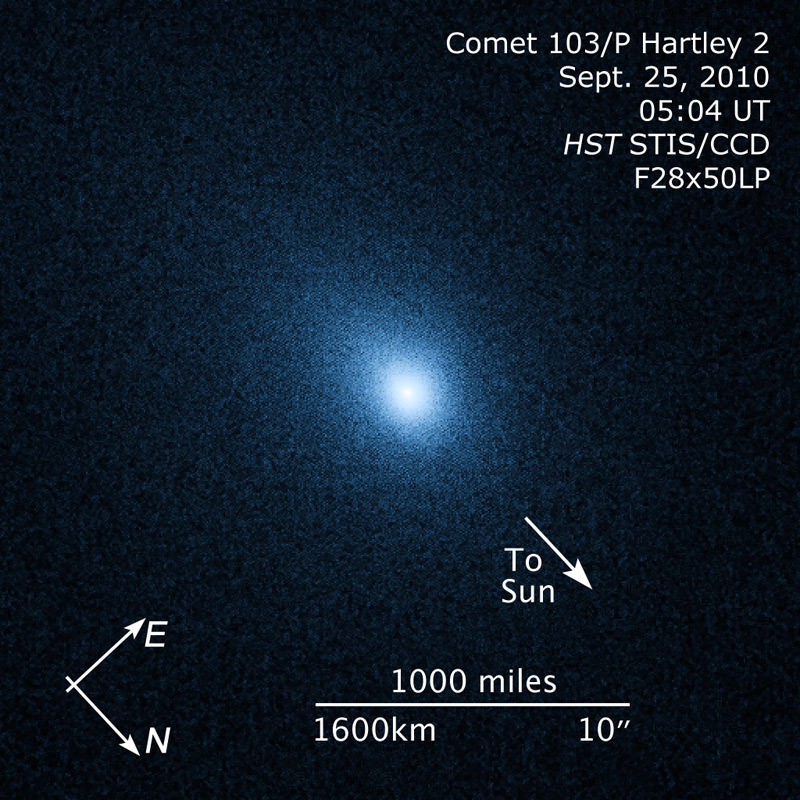[/caption]
In a little less than a month, NASA’s Deep Impact spacecraft (its current mission is called EPOXI) will fly by the comet Hartley 2 to image the comet’s nucleus and take other measurements. In preparation for this event, both the Wide-field Infrared Survey Explorer (WISE) and the Hubble Space Telescope have imaged the comet, scouting out the destination for Deep Impact.
On November 4th of this year, Deep Impact will come within 435 miles (700 km) of the comet Hartley 2, close enough to take images of the comet’s nucleus.
The name of the mission is EPOXI, which is a combination of the names for the two separate missions the spacecraft has been most recently tasked with: the extrasolar planet observations, called Extrasolar Planet Observations and Characterization (EPOCh), and the flyby of comet Hartley 2, called the Deep Impact Extended Investigation (DIXI). The spacecraft itself is still referred to as Deep Impact, though, despite the changes and extensions of its mission.
NASA’s Deep Impact mission to slam a copper weight into comet Tempel 1 was a wonderful success, sending back data that greatly improved our understanding of the composition of comets. After the encounter, though, there was still a lot of life left in the spacecraft, so it was tasked with another cometary confrontation: take images of the comet Hartley 2.
Deep Impact is an example of NASA using a single spacecraft to perform multiple, disparate missions. In addition to impacting and imaging Tempel 1 and performing a flyby of Hartley 2, the spacecraft took observations of 5 different stars outside of our Solar System during the period between January and August of 2008 (8 were scheduled, but some observations were missed due to technical difficulties).
It looked at stars with known exoplanets to observe transits of those planets in front of the star, giving astronomers a better idea of the orbital period, albedo – or reflectivity – and size of the planets.
Click here for a list of the various stars and transits it observed, as listed on the mission page.
Deep Impact also took data on both the Earth and Mars as they passed in front of our own Sun, to help characterize what exoplanets with a similar size and composition the Earth and Mars would look like passing in front of a star.

As of September 29th, Deep Impact was about 23 million miles (37 million km) away from Hartley 2. It is approaching at roughly 607,000 miles a day (976,000 km), so that puts it at about 18 million miles (29 million km) away from the comet today. As it approaches, Deep Impact will speed up, to over 620,000 miles (1,000,000 km) per day.

You won’t have to depend on NASA’s observatories and the spacecraft to see a view of Hartley 2, though – you should be able to see it with the naked eye or binoculars near the constellation Perseus throughout the month of October. On October 20th, it will make its closest approach to Earth at a distance of 11 million miles (17.7 million km). The comet is officially designated 103P Hartley, and for viewing information you can go to Heavens Above.
As always, check this space regularly for updates on the upcoming flyby.
Sources: JPL here, here and here, Hubblesite, Heavens Above


I saw C. Hartley last Sunday night in a 4.5″ Meade Newtonian no prob…. Driveway astronomy! I was unable to resolve the coma but did see a condensation in the cloud like mass…
I’ve been following the comet for the past week as it travels through northern Perseus using 7×50 binoculars and a 4.25″ f8 reflector. Not quite a naked eye object, but close, from my suburban location. On October 7(tonite) and 8 the comet passes within 1 degree of the Double Cluster in Perseus. This proximity should make it easier to locate in binoculars(and be quite a sight in a low power field). October 19-20 the comet will be slightly brighter(possibly a naked eye object) and near the bright star Capella in Auriga. Sky & Telescope has a page on observing Hartley 2: http://www.skyandtelescope.com/observing/home/102632669.html
Finder charts: http://media.skyandtelescope.com/images/CometHartley2-bw.jpg
The comet’s proximity to Earth will make it appear to move rather quickly across the sky over the next few weeks. Should be interesting to follow it from the ground and in space.
Tonight’s looking good weather wise here for looking at the comet! This is the 44th comet I’ve seen……*
It’s only the 4th Comet I’ve seen since getting a telescope, I think it’s my 6th overall.
On Sept 29, I couldnt see it at all with binoc’s and could only just tell it was there with a 7.5inch Mak Newt telescope, but i’m in light polluted skies (mag 3.5).
It aint hubble, but here’s what my Mak Newt saw that night (after stacking several exposures):
http://www.flickr.com/photos/suraky/5050456486/in/photostream/
Can’t wait until the weather clears up again here.